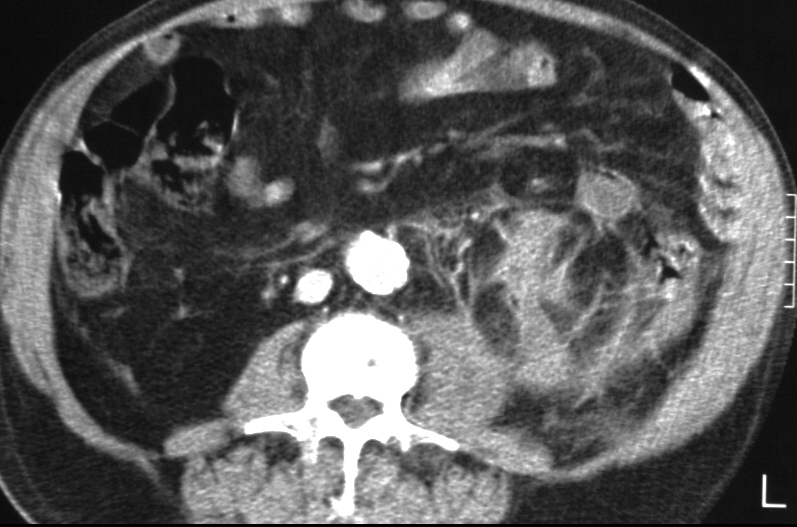
Patient has acquired cystic disease of chronic failure and presents wit spontaneous subcapsular hemorrhage of the left kidney. A hemorrhage from a malignancy known to occur as a complication of this entity was suspected. At the inferior aspect of the hemorrhage there is extension of the process into the retroperitoneum giving the appearance of the “spider web sign” or “cobweb sign”
Ashley Davidoff MD TheCommonVein.net RnD

Patient has acquired cystic disease of chronic failure and presents wit spontaneous subcapsular hemorrhage of the left kidney. A hemorrhage from a malignancy known to occur as a complication of this entity was suspected. At the inferior aspect of the hemorrhage there is extension of the process into the retroperitoneum giving the appearance of the “spider web sign” or “cobweb sign”
Ashley Davidoff MD TheCommonVein.net RnD
“Cobweb sign” can be used interchangeably with the term “spider web sign” in the context of radiological findings of retroperitoneal bleeding. Both terms are used to describe the appearance of a complex network of fine linear strands or streaks that resemble a cobweb or a spider web on imaging studies, particularly on CT scans of the retroperitoneum. They both refer to the presence of blood products within the retroperitoneal space.
These descriptive terms are employed by radiologists to convey the specific appearance of the retroperitoneum following a bleed. The use of either term, “cobweb sign” or “spider web sign,” serves to highlight the intricate and delicate pattern observed on the imaging, and both imply the presence of bleeding within the retroperitoneal space.
It is characterized by a complex network of fine linear strands or streaks that represent blood products within the retroperitoneum. These strands can create a web-like appearance on imaging, hence the term “spider web sign.”
Retroperitoneal bleeding can occur due to various causes, including trauma, rupture of abdominal aortic aneurysm, bleeding disorders, or complications of medical procedures. The “spider web sign” is a descriptive term used by radiologists to communicate the specific appearance of blood within the retroperitoneal space.
If a CT scan shows the “spider web sign,” it suggests the presence of retroperitoneal bleeding, and the severity and implications of this finding would depend on the underlying cause and the extent of the bleed. Prompt and accurate diagnosis is crucial in such cases, as significant retroperitoneal bleeding can have serious implications and may req
